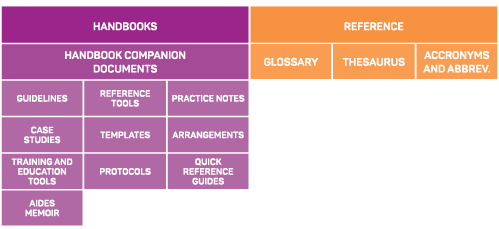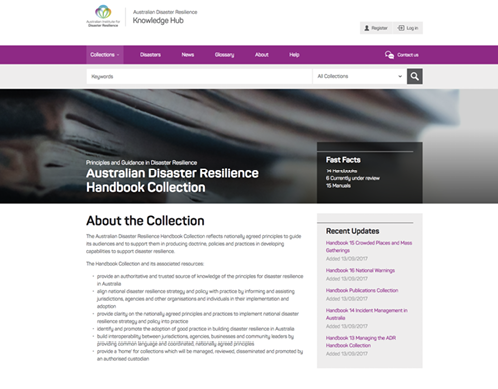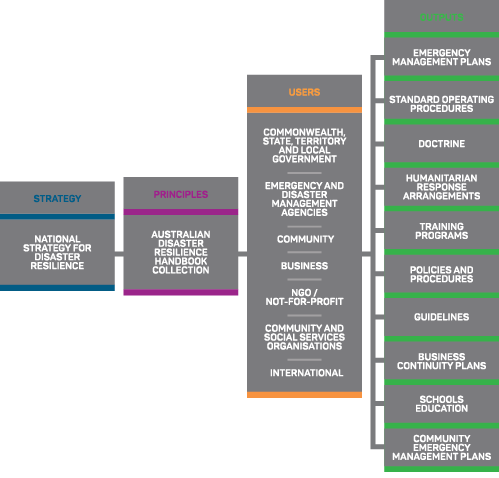New handbooks for the Handbook Collection
Amanda Lamont, Australian Institute for Disaster Resilience
Article
An updated Evacuation Planning Handbook and a new Communities Responding to Disasters: Planning for Spontaneous Volunteers handbook profile new nationally agreed principles for these areas. These Handbooks form part of the Australian Disaster Resilience Handbook Collection.
The current Handbook Collection, managed by AIDR, includes 16 handbooks, six that are currently under review or development. The handbooks provide an all-hazards national perspective, focusing on principles and guidance. They can be used to support anyone working in the disaster context in developing policies and plans, including emergency management practitioners, government and community groups.
The new Communities Responding to Disasters: Planning for Spontaneous Volunteers Handbook explores spontaneous volunteering in an emergency context. It provides guidance to those working with spontaneous volunteers about how to harness this capability and bring communities and the emergency services sector together. As we have seen from the recent floods in Queensland and NSW following Tropical Cyclone Debbie, people are motivated to assist in response and recovery after disasters. Harnessing this capability is essential for the emergency management agencies, local councils, NGOs and other community groups that work together after disaster.
The new Handbook outlines principles and guidelines that organisations can adopt to support spontaneous volunteers through a set of guiding questions, strategies and advice. It also provides additional case studies and examples of strategies and approaches from Australia and other countries.
The 2017 revision of the Evacuation Planning Handbook draws on expertise across jurisdictions, the emergency management sector, community, government and non-government organisations to review and address changes to evacuation planning and issues that have emerged since the publication of the previous Handbook in 2013.
Central to the Handbook is the safety of community members and emergency responders during the evacuation process and the early return of evacuees to minimise negative social and economic impacts on affected communities. This revision recognises the complexity of evacuations and human behaviour, influences of technology and social media and consideration of evacuation planning for all hazards. Significant development of sections on animal management has also been completed.
The handbook uses the nationally agreed five stages of the evacuation process as a framework for planning an evacuation: Decision, Warning, Withdrawal, Shelter, Return.
The Evacuation Planning Handbook can be used to prepare evacuation plans before disasters arise, to maximise the efficiency and effectiveness of any evacuation that may be necessary. Evacuation plans may be specific to a hazard and a location or more generic in nature, in recognition of the need to adapt generic plans to the specific time, place and circumstance of a given event.
The following handbooks are being reviewed and developed during 2017-18:
- Community Recovery
- Australian Emergency Management Arrangements
- National Warnings
- Safe & Healthy Crowded Places and Mass Gatherings
- Incident Management in Australia.
The Handbook Collection is published on the Australian Disaster Resilience Knowledge Hub at www.knowledge.aidr.org.au/collections/handbook-collection.

The Handbook Collection and companion documents.
What is the Handbook Collection?
The Australian Disaster Resilience Handbook Collection outlines nationally agreed principles and guidance in disaster resilience, across different disasters, jurisdictions, contexts and stakeholders.
The principles presented in the Handbook Collection are the result of expertise, experience, learning, theoretical analysis, data analysis, research utilisation and collaboration among agencies, organisations, governments and communities that provide and receive services and support during disasters.
The Handbook Collection provides links across the collection and to other national and international collections to facilitate knowledge–sharing, adoption, implementation and distribution by users across organisations, individuals, jurisdictions, disasters and contexts.

The future of the Handbook Collection
The first publications in the original Australian Emergency Manual Series were skills reference manuals produced from 1989 onwards. In 1996, the series was expanded to include comprehensive emergency management principles and practice reference publications.
In 2011, handbooks were introduced to align with the National Strategy for Disaster Resilience, comprising principles, strategies and actions to help the management and delivery of support services during disasters.
In 2015, AIDR was appointed custodian of the handbooks and manuals to provide guidance on the national principles and supporting disaster resilience in Australia through management and publication of the Handbook Collection.
A detailed examination of the existing Handbook Collection is being undertaken to determine which publications should be retained, where they fit within the Handbook Collection, which should be retired and archived or devolved to another custodian. Retained publications will enter a lifecycle management program for review. This review process will progressively align existing and new publications with the publication style described in the framework.
There are currently 16 handbooks in the collection as well as companion documents that support adaptation and implementation. There are 15 manuals identified in the manual series that will be reviewed and transitioned into the Handbook Collection. The remaining manuals have been archived or moved to other collections to be managed by other custodians, including AFAC.

The Handbook Collection will continue to evolve as a leading authoritative collection of nationally agreed principles and guidance supporting disaster resilience in Australia.


